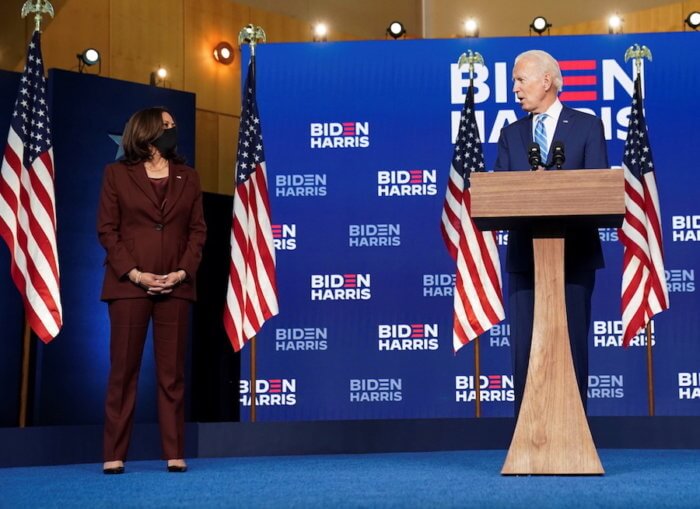With Pennsylvania’s 20 electoral votes and Nevada’s six now called for Democrat Joe Biden by the Associated Press, he is the president-elect of the United States and will become the nation’s 46th commander-in-chief on January 20.
The Pennsylvania and Nevada calls gives Biden 279 electoral votes, nine more than needed, and he maintains narrow leads in two other states, Georgia, by 7,248 votes and Arizona — which the Associated Press but not all major news outlets have given to Biden — by 20,573 votes. Winning those two states would give the president-elect 306 electoral votes, the exact number Donald Trump won four years ago in his upset victory over former Secretary of State Hillary Clinton.
Biden’s victory came by restoring the Great Lakes Blue Wall of Pennsylvania, Michigan, and Wisconsin, Democratic states for the previous several decades of presidential contests that fell to the GOP in 2016.

Elsewhere, Biden held onto all of Clinton’s 2016 states.
If Biden holds onto his leads in Georgia and Arizona, he will have also flipped two traditionally Republican states that have not gone for the Democratic presidential candidate since 1992 and 1996, respectively.
Biden’s popular vote advantage is currently estimated at 4,151,365 — 74,488,579 to 70,337,214. Biden’s margin over Trump is expected to increase as the vote counts are finalized nationwide.
America, I’m honored that you have chosen me to lead our great country.
The work ahead of us will be hard, but I promise you this: I will be a President for all Americans — whether you voted for me or not.
I will keep the faith that you have placed in me. pic.twitter.com/moA9qhmjn8
— Joe Biden (@JoeBiden) November 7, 2020
Though Democrats have won the main prize, they faced a tougher slog in House and, crucially, Senate races.
So far, Democrats, who need a net gain of three seats with the tie-breaking vote of Vice President-Elect Kamala Harris, have so far only gained one seat. Former Governor John Hickenlooper of Colorado and Mark Kelly in Arizona put two Democratic gains on the board, but Alabama’s Doug Jones, who won a special election to replace Jeff Sessions in 2017, was defeated.
Democrats were disappointed in their hopes to defeat Republican Senators Susan Collins in Maine, Steve Daines in Montana, Joni Ernst in Iowa, and Lindsey Graham in South Carolina.
Two Republican senators — Thom Tillis in North Carolina and Dan Sullivan in Alaska — have not yet been called as victors, though Tillis is expected to hold onto his seat and the vote count in Alaska remains very slow.
That means that control of the Senate seems destined to be determined by two run-off elections likely in Georgia on January 5.
In a three-way race to fill out the final two years of retired GOP Senator Johnny Isakson, Democrat Raphael Warnock outpolled Senator Kelly Loeffler, the appointee named temporarily to Isakson’s seat, by more than five points. Since Warnock, at 33 percent, fell short of the 50 percent needed for outright victory, a Warnock-Loeffler runoff will happen on January 5. It is worth noting that the tally for the third place finisher, Republican Congressmember Doug Collins, combined with Loeffler’s votes, totaled 46 percent. The runoff will be hard fought.
In Jon Ossoff’s challenge to incumbent Republican David Perdue — who has faced charges he engaged in insider trading in response to an official briefing he received on the severity of the COVID crisis, even as he downplayed the threat with Trump-loyalist rhetoric — the Democrat appears to have held Perdue below the 50 percent threshold, and those two candidates also appear poised to face each other again on January 5.
In House races, the Democrats who had hoped to expand their 232 to 197 advantage appear to have lost seats but are expected to retain control of the chamber. So far, the Associated Press has called all but 33 races, with Democrats at 209 and Republicans at 193.
In New York State, incumbent Democrat Max Rose of Staten Island and Brooklyn is down by 12 points to Assemblymember Nicole Malliotakis , a margin seemingly difficult to overcome as absentee ballots are tallied.
Similarly, upstate, first-term Democrat Anthony Brindisi trails former Congressmember Claudia Tenney by 11 points in a rematch of their 2018 contest.
On Long Island, Democratic incumbent Tom Suozzi trails out gay GOP challenger George A.D. Santos by one and a half points or just under 7,000 votes, a margin that still has the potential of flipping when absentee votes are tallied.
Should Santos hold on, New York would have an unprecedented four gay House members — the other three Democrats — with four-term incumbent Sean Patrick Maloney and newcomers Ritchie Torres of the Bronx and Mondaire Jones of Northern Westchester and Rockland County.
To sign up for the Gay City News email newsletter, visit gaycitynews.com/newsletter.



































